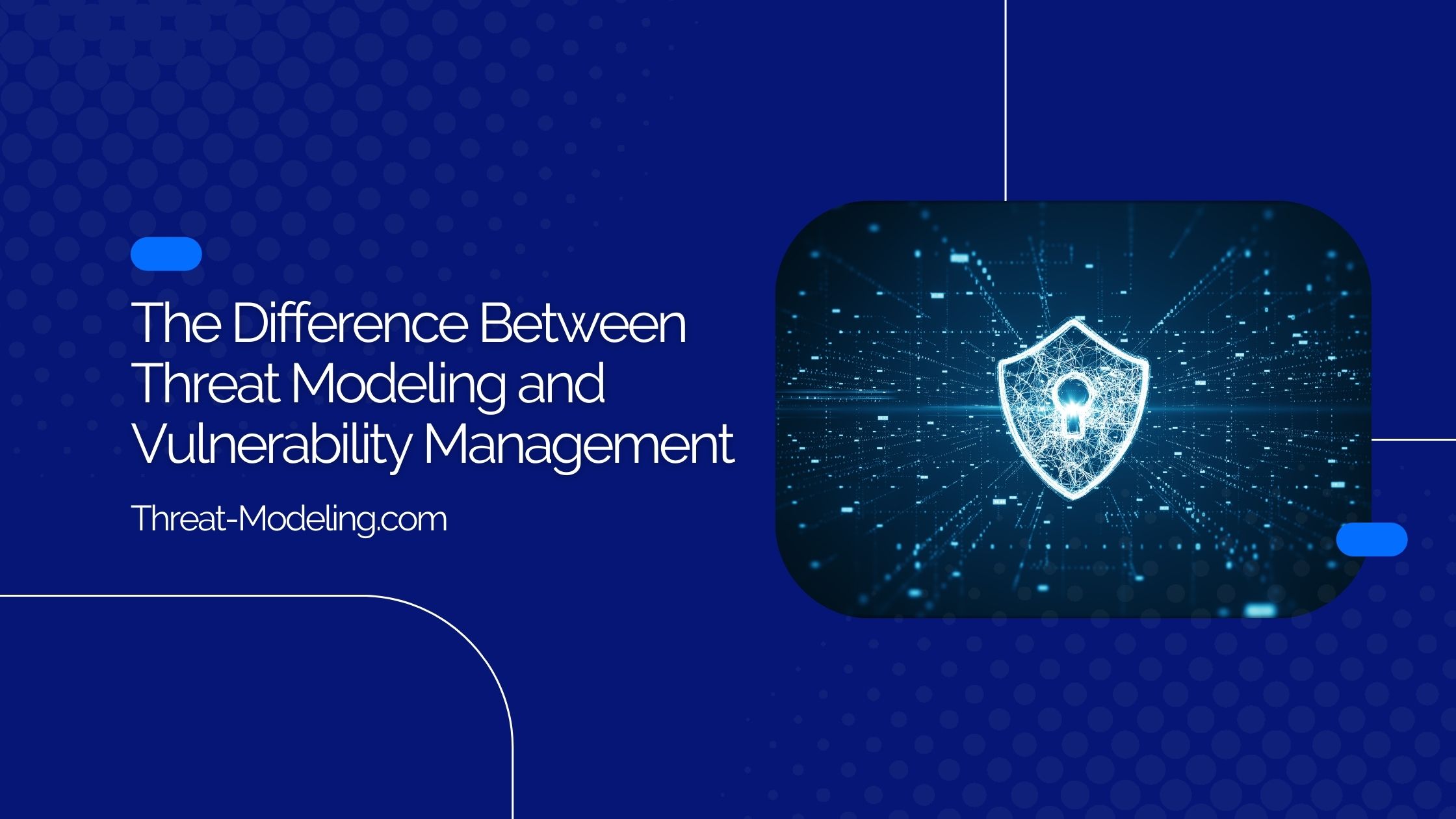Threat modeling and vulnerability management are both essential components of a comprehensive cybersecurity program. Both are used to identify weaknesses in applications and IT systems – but each focuses on a different type of weakness. Threat modeling identifies potential threats and weaknesses at the design level. Vulnerability management identifies software vulnerabilities. This article, about threat modeling versus vulnerability management, will describe the differences between the two, as well as commonalities and how they can complement each other.
Threat modeling is a structured approach to identifying and understanding potential threats to a system. It involves analyzing the system design, looking for potential threats, and determining the value of potential mitigations in reducing or neutralizing those threats. By identifying potential threats early in the development process, threat modeling can help companies build more secure systems and reduce the likelihood of successful attacks.
Vulnerability management, on the other hand, focuses on identifying software vulnerabilities. This involves scanning systems and applications for known vulnerabilities and prioritizing them based on their severity and potential impact. By addressing vulnerabilities promptly, organizations can reduce their attack surface and better protect their systems and data.
What is Threat Modeling
Threat modeling is a proactive approach to identifying potential threats and vulnerabilities in an application, IT system or business process. It involves analyzing the architecture, identifying potential threats and vulnerabilities, and developing countermeasures (or security requirements) to mitigate those threats.
Threat modeling helps security teams to visualize and analyze potential threats to an application, IT system or business process. It provides a structured approach to identifying and addressing security issues before they can be exploited by attackers.
Threat modeling has several steps and characteristics (depending on which specific method you use):
- Understanding the environment (i.e., what we’re working on).
- Understanding the potential threats that may apply (i.e., what could go wrong).
- Understanding the countermeasures to those threats (i.e., what are we going to do about the threats).
- Understanding whether we did a good job.
Threat modeling can be used at various stages of the software development lifecycle, including during the design phase, development phase, and testing phase. By identifying and addressing security issues early in the process, organizations can reduce the likelihood of security incidents and minimize the impact of any incidents that do occur.
Threat Modeling Methods
Threat modeling has many different threat modeling methods, such as the STRIDE threat modeling method, or the PASTA threat modeling method. There isn’t a single way (or method) to perform threat modeling.
Threat Modeling Tools
Threat modeling also has many threat modeling tools that are available.
In fact, we have a threat modeling tool that can help you to perform threat modeling effectively. Two other well-known threat modeling tools are Microsoft Threat Modeling Tool and OWASP Threat Dragon.
We also have automated threat modeling solutions. This allows you to perform threat modeling faster and more effectively.
What is Vulnerability Management
Vulnerability management is a crucial aspect of cybersecurity that involves identifying, assessing, and addressing potential security weaknesses in computer systems, networks, and enterprise applications. It is a continuous, proactive, and often automated process that helps organizations keep their systems safe from cyberattacks and data breaches.
The vulnerability management process typically involves several steps, including:
- Scanning: Using automated tools to scan systems and applications for known vulnerabilities.
- Assessment: Analyzing the results of the scans to identify vulnerabilities that pose the greatest risk to the organization.
- Prioritization: Ranking vulnerabilities based on their severity and potential impact on the organization.
- Remediation: Addressing vulnerabilities by applying patches, implementing security controls, or taking other measures to reduce the risk of exploitation.
- Verification: Testing systems and applications to ensure that vulnerabilities have been properly addressed and that the risk of exploitation has been mitigated.
Vulnerability management is a critical component of an overall security program and helps organizations stay ahead of cyber threats by proactively identifying and addressing potential vulnerabilities before they can be exploited. By implementing an effective vulnerability management program, organizations can reduce the risk of data breaches, protect sensitive information, and safeguard their reputation.
Key Differences between Threat Modeling and Vulnerability Management
Threat modeling and vulnerability management are two different approaches to security that organizations can use to protect themselves from cyber threats. While both are important, there are some key differences between the two. Here are some of the main differences:
- Timing: The main difference between threat modeling and vulnerability management is timing. Threat modeling is a proactive approach that helps security teams visualize and analyze potential threats before they occur. In contrast, vulnerability management is a reactive approach that focuses on identifying and addressing vulnerabilities after they have been discovered.
- Focus: Another key difference is the focus of each approach. Threat modeling focuses on identifying and mitigating threats to an organization’s assets, while vulnerability management focuses on identifying and addressing vulnerabilities in an organization’s systems and applications.
- Scope: Threat modeling is typically done at the design phase of a project and covers the entire system or application. Vulnerability management, on the other hand, is an ongoing process that covers specific systems or applications.
- Methodology: Threat modeling uses a structured methodology to identify and analyze potential threats. Vulnerability management, on the other hand, uses a variety of tools and techniques to identify vulnerabilities, such as vulnerability scanning and penetration testing.
Overall, both threat modeling and vulnerability management are important approaches to security that organizations can use to protect themselves from cyber threats. By understanding the key differences between the two, organizations can choose the approach that best fits their needs and helps them achieve their security goals.
Benefits of Threat Modeling
Threat modeling is a proactive approach to security that can provide numerous benefits to organizations. Here are a few key advantages:
- Identifying potential security threats: By analyzing the system architecture and identifying potential weaknesses, threat modeling can help organizations anticipate and prevent security threats before they occur.
- Prioritizing security efforts: Threat modeling can help organizations prioritize their security efforts by identifying the most critical threats.
- Reducing the attack surface: By identifying and addressing vulnerabilities, threat modeling can help organizations reduce their attack surface, making it more difficult for attackers to exploit weaknesses.
- Improving collaboration: Threat modeling can help bring together different teams within an organization, including developers, security professionals, and business stakeholders. By working together, these teams can better understand the security risks and develop more effective solutions.
- Compliance: Many regulatory frameworks, such as PCI DSS and HIPAA, require organizations to conduct threat modeling as part of their security programs. By conducting threat modeling, organizations can ensure that they are meeting these compliance requirements.
Overall, threat modeling can help organizations build more secure systems by identifying potential threats and developing effective countermeasures (via security requirements).
By taking a proactive approach to security, organizations can reduce their risk of cyberattacks and protect their critical assets.
Benefits of Vulnerability Management
Vulnerability management is a critical part of maintaining the security of an organization’s IT environment. It helps to identify and prioritize vulnerabilities in the system, which can then be addressed before they are exploited by attackers. Here are some of the benefits of implementing a vulnerability management program:
- Reduced risk: By identifying and addressing vulnerabilities in a timely manner, the overall risk to the organization is reduced. This can help to prevent data breaches and other security incidents.
- Improved compliance: Many regulatory frameworks require organizations to implement a vulnerability management program. By doing so, organizations can ensure that they are meeting their compliance obligations.
- Cost savings: Addressing vulnerabilities before they are exploited can help to prevent costly security incidents. It can also reduce the amount of time and resources required to respond to a security incident.
- Increased visibility: A vulnerability management program provides greater visibility into the security of an organization’s IT environment. This can help to identify areas that require additional attention and resources.
Overall, implementing a vulnerability management program can help to improve the security posture of an organization and reduce the risk of security incidents. By identifying and addressing vulnerabilities in a timely manner, organizations can stay one step ahead of attackers and protect their valuable data and assets.
Threat Modeling Versus Vulnerability Management – Conclusion
Threat modeling and vulnerability management are two different approaches to securing an organization’s assets. While they have some similarities, they are fundamentally different in their goals and methods.
Threat modeling is a proactive approach that involves identifying potential threats and vulnerabilities in a system or application before they can be exploited. It helps organizations understand the risks they face and prioritize their security efforts accordingly.
Vulnerability management, on the other hand, is a reactive approach that involves identifying and mitigating vulnerabilities in a system or application after they have been discovered. It is a critical component of any security strategy, but it is not sufficient on its own.
Threat modeling and vulnerability management can complement each other and help organizations build a more comprehensive security strategy. By combining the two approaches, organizations can identify potential threats and vulnerabilities, prioritize their security efforts, and take proactive steps to mitigate risks.
Ultimately, the choice between threat modeling and vulnerability management will depend on an organization’s specific needs and circumstances. Some organizations may prioritize threat modeling to identify potential threats and vulnerabilities, while others may focus more on vulnerability management to address known vulnerabilities.
Regardless of which approach an organization chooses, it is important to remember that security is an ongoing process. Threats and vulnerabilities are constantly evolving, and organizations must remain vigilant and adaptable to stay ahead of them.


